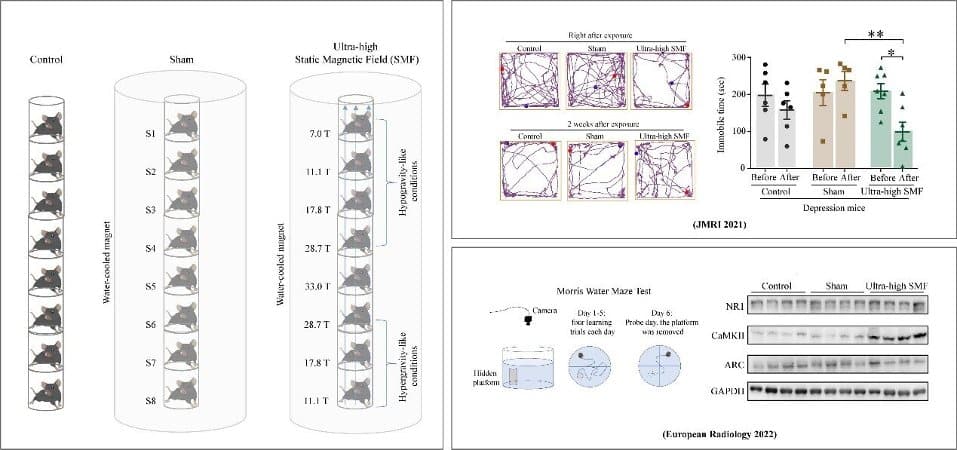Summary: Exposure to high static magnetic fields alleviated anxiety and improved both spatial and social memory in mice within two months of exposure.
Source: Chinese Academy of Science
Prof. Zhang Xin’s team at the Hefei Institutes of Physical Science of the Chinese Academy of Sciences has recently conducted a series of studies to test the biosafety and neurobehavioral effects of 33.0 Tesla (T) high static magnetic field (SMF) using the self-designed biological research platform of Steady High Magnetic Field Facility (SHMFF).
They for the first time reported the biosafety of 30 T level SMF and the neurobehavioral effects of 20 T and 30 T level SMF on healthy mice in in the Journal of Magnetic Resonance Imaging and European Radiology.
In recent years, ultra-high field magnetic resonance imaging (MRI) has developed rapidly due to its significant advantage of high imaging resolution. 7 T MRI has been clinically approved and 21.1 T MRI has been successfully used in rodents. However, studies on biosafety of high magnetic field above 20 T are still scarce, and there is still a gap in relevant studies above 30 T.
Based on the previous biosafety study of 3.5-23.0 T SMF, Zhang Xin’s group further increased the magnetic field intensity and shortened the exposure time. Healthy C57BL/6J mice were exposed to 7.0-33.0 T SMF for one hour.
After exposure, all mice were routinely fed for two months. Except for a few metabolic and liver and hepatorenal function indicators affected by magnetic field, the whole blood count, organ coefficient on histomorphology of main organs were not seriously affected, and most of them were still within the normal reference range.

Meanwhile, behavioral tests showed that high SMF alleviated anxiety and improved social and spatial memory in mice within two months after exposure.
In addition, behavioral studies of healthy mice exposed to a 3.5-23.0 T magnetic field for two hours also found improved neurocognitive effects, which may be associated with increased calcium/calmodulin-dependent protein kinase II expression in the mouse hippocampus.
Zhang’s group further found that 7 T SMF could effectively relieve symptoms of depressed mice. These results not only provide useful safety information for the development of ultra-high MRI, but may also indicate that high SMF has the potential to be a future antidepressant treatment.
About this anxiety and neurotech research news
Author: Zhang Nannan
Source: Chinese Academy of Science
Contact: Zhang Nannan – Chinese Academy of Science
Image: The image is credited to Lyu Yue
Original Research: Closed access.
“Short- and long-term effects of 3.5–23.0 Tesla ultra-high magnetic fields on mice behaviour” by Md Hasanuzzaman Khan et al. European Radiology
Abstract
Short- and long-term effects of 3.5–23.0 Tesla ultra-high magnetic fields on mice behaviour
Objectives
Higher static magnetic field (SMF) enables higher imaging capability in magnetic resonance imaging (MRI), which encourages the development of ultra-high field MRIs above 20 T with a prerequisite for safety issues. However, animal tests of ≥ 20 T SMF exposure are very limited. The objective of the current study is to evaluate mice behaviour consequences of 3.5–23.0 T SMF exposure.
Methods
We systematically examined 112 mice for their short- and long-term behaviour responses to a 2-h exposure of 3.5–23.0 T SMFs. Locomotor activity and cognitive functions were measured by five behaviour tests, including balance beam, open field, elevated plus maze, three-chamber social recognition, and Morris water maze tests.
Results
Besides the transient short-term impairment of the sense of balance and locomotor activity, the 3.5–23.0 T SMFs did not have long-term negative effects on mice locomotion, anxiety level, social behaviour, or memory. In contrast, we observed anxiolytic effects and positive effects on social and spatial memory of SMFs, which is likely correlated with the significantly increased CaMKII level in the hippocampus region of high SMF-treated mice.
Conclusions
Our study showed that the short exposures to high-field SMFs up to 23.0 T have negligible side effects on healthy mice and may even have beneficial outcomes in mice mood and memory, which is pertinent to the future medical application of ultra-high field SMFs in MRIs and beyond.







